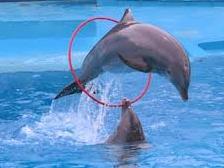Positive Reinforcement Dog Training
Great dog training is getting a dog to WANT to do whatever behaviour the owner wants him to do. To be really successful trainers need to utilise the fundamental laws of learning which – like the laws of gravity – never fail to work.
The first step to great animal training is to understand that any behaviour, whether good or bad, that is rewarded is likely to happen again, that behaviours that are ignored will extinguish and that learned behaviours that are reinforced on an unpredictable basis become highly reliable. It was not always so but dolphins have been taught like this for years. These days leading zoo keepers and dog trainers around the world know too that their exotic animals and dogs trained the same way are capable of equally fantastic performances.

In the late 1930s Professor B. F. Skinner from Harvard discovered that rats and all animals can be taught to perform a series of complex operations voluntarily in order to obtain an essential need - such as a piece of food. Skinner's views that there was no need for punishment in training any kind of animal - humans included - were at first ridiculed. However, from the mid 1970s onwards those people around the world seeking ways to improve animal and human education have understood, accepted and adopted his ideas.
Some dog trainers felt that there must be better methods to teach their dogs and to modify behaviour other than through the traditional ways, such as ‘house breaking’ and punishing a puppy for pooping on the carpet. Their thinking coincided with the changes that were taking place in the treatment of people with physical disabilities and mental health problems who had often been subjected to aversive stimuli and electric shock therapy in order to prevent their problem behaviours.
Positive reinforcement for dog training dog was first used in Australia in 1976 at the Kintala Dog club in Melbourne founded by the late David Weston.
In 1966 he had acquired a Miniature Schnauzer puppy that he took aged 6 months to a nearby dog obedience club. He says, “during the next few years I worked hard at learning and applying the knowledge which the club had to offer, and as a consequence I became a Kennel Control Council certified instructor, a full panel obedience judge and President of the Club. During this period 'Fred' gained his Companion Dog (C.D.) and Companion Dog Excellent (C.D.X) titles.
However, I became increasingly disenchanted with the method of training used by dog clubs in general. Much of the knowledge that supported their method appeared to be based on archaic principles and involved a great deal of punishment and compulsion. Training essentially consisted of jerking the dog in the neck with a choker chain, physically pressuring it into position, and growling at the dog using commanding voice tones.
When the dog responded in a way that was favourable to the handler it was rewarded with a pat and verbal praise. Many of the responses generated were accompanied by a strong fear reaction in the dogs, as could be seen by the lowering of their ears and tails, and unwillingness to return voluntarily to the handlers''.(‘Dog Training, the Gentle Modern Method '- 1990, page 9)
At the Kintala Dog Club traditional training methods with check chains, physical force and manipulation were totally banned. More than 30 years later David Weston’s gentle modern methods, which initially were considered heretical, are widely used around the world at progressive dog obedience clubs and organisations such as the RSPCA. These training establishments only use positive reinforcement methods where:
- A new behaviour is broken down into several individual parts, each of which is learned before taking the next step. The dog is set up to succeed.
- Any improvement is rewarded - at first usually with food. Food is essential to survival and therefore a more powerful motivator than a non-essential one such as a pat or praise.
- A poor behaviour is simply ignored. The punishment is "not rewarding" and the habit soon extinguishes - as with humans where a poor joke is receives the negative punishment of no laughter.
- Once a desired behaviour is learned, food should be phased out and replaced with other rewards such as praise, toys or everyday life rewards of having or doing whatever the dog most wants to do have or do next.
- The dog realises that he has the ability to affect what happens. He will be paid, or reinforced, in return for working correctly. It is a win/win situation with both sides co-operating with each other rather than engaging in an adversarial war of wills.
Many dog trainers have seen the incredible results of positive reinforcement training with the family pet dog, as well as in dog sports and competitions. Reward based reinforcement training makes rapid progress and is fun for both teacher and student. These trainers have welcomed the accelerated learning curve, as well as the vitality and initiative to experiment, that comes when animals learn because they want to and not because they have to.
© C.L.E.A.R Dog Training 2001
Postscript:
In 2009 a highly accomplished Norwegian trainer, Morten Egtvedt, wrote about his book “Clicker Training: The Four Secrets of Becoming a Super Trainer”:
“I would never say that correction-based training does not work. Of course it works! Dogs are not stupid. They are survivors. If they have to walk on a loose leash or come when called to avoid pain, they will. Violent husbands sometimes have very "obedient" wives, too. But because something "works" does NOT mean it´s “good”.
..............
There are two kinds of positive dog training. There is lousy positive training and there is effective positive training. So what makes positive training lousy and what makes positive training effective?
I would say that it depends partly on the training methodology itself, and partly on how the training is executed by the trainer (trainer skills). I have seen a lot of bad "positive training" in my time (and even more bad punishment-based training, but let´s leave that for now).
There are many positive trainers who base their training on luring (bribing) the dog to get behavior. This kind of training may work OK sometimes, but I consider it old-fashioned and not very interesting - it’s definitely not supertraining!
Instead I use clicker training! And I consider clicker training to be an extremely effective(positive) training technique WHEN IT IS USED CORRECTLY. In clicker training we don´t lure or bribe the dog. The treats are well hidden in our pockets until the dog offers the right behavior on his own. THEN we click and treat. This is a huge difference!
[A completely incorrect use of a clicker is to use it as a call signal! Equally mistaken is to use one as an attention getter!! Unfortunately some people who buy a clicker frequently do so, especially when training for the show ring, and click-click-click away randomly without having any idea of its purpose. They don’t understand the necessity of properly conditioning the clicker (a la Pavlov) by first spending some days pairing a meaningless stimulus (the sound of the clicker or the dolphin trainer’s whistle) to something that is greatly desired - the fish, the dried liver or piece of sausage, the pat, the verbal praise or the tug toy. Nor do they know that once the clicker has been adequately conditioned, the one and only function of a single click is as a conditioned secondary reinforcer used to give very specific information and, so importantly, to separate that precise information from the subsequent reward].
When you are clicker training (and again, I´m talking about supertraining - not just using the clicker as a marker) the dog learns to THINK. The dog learns to solve problems, to experiment, to be creative. The dog feels a sense of control of the training situation - and he loves it!
Very soon you will discover that your dog has become a LEAN, MEAN LEARNING MACHINE capable of learning new behaviours and tricks in record time! You won´t believe how much fun dog training can be until you have a dog like this”.


